Clothes-How Things are Made NCERT Solutions | Our Wondrous World Class 5 - New NCERT PDF Download
| Table of contents |

|
| Page No. 133 |

|
| Page No. 134 |

|
| Page No. 136 |

|
| Page No. 138 |

|
| Page No. 139 |

|
| Page No. 140 |

|
| Page No. 141 |

|
| Page 143-144 |

|
Page No. 133
Discuss
Q. Have you seen products woven out of natural material at home or elsewhere? What are they?
Answer: Yes, examples include mats, baskets, sheets made from coconut fibre, palm reeds, bamboo, grass, jute, cotton, or silk.
Activity 1
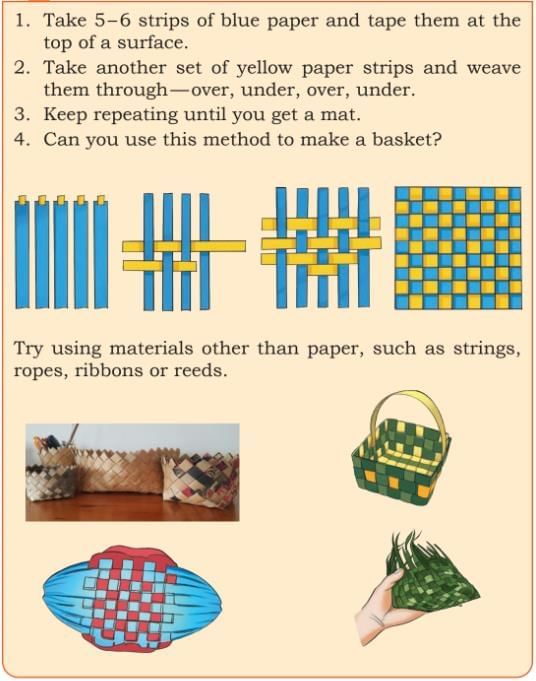
This activity teaches us how to weave by using paper strips. First, I taped 6 blue strips onto my table. Then, I took yellow strips and carefully wove them over and under the blue strips, making a checkered mat. I kept repeating this pattern until my mat was complete.
I learned that weaving means crossing strips over and under each other. This method can be used to make mats, baskets, and many other things. I also saw in the pictures that people use materials like reeds and ribbons to make baskets.
Yes, I tried this weaving activity.
I followed the steps and made a woven mat using blue and yellow paper strips by going over and under each strip, just like in the instructions. It created a checkerboard pattern, and I was surprised how strong the mat felt, even though it was made of paper. After finishing the mat, I realised I could use the same method to make different things, like a simple basket or a decorative piece. It was a fun and creative craft that showed me how weaving can turn plain materials into something useful!
Page No. 134
Think
Q. What can you find in your classroom that is woven? If we weave with threads instead of paper strips, it becomes cloth.
Answer: In your classroom, you can find several items that are woven, such as:
- Curtains or drapes made of fabric
- Your school uniform or the clothes you wear
- Bags or backpacks made from fabric
- Rugs or mats placed in the room
- Pencil cases or cloth pouches
- Book covers made from woven cloth
When threads are woven together instead of paper strips, the result is cloth, which is soft, flexible, and used to make many everyday items like clothes, bags, and curtains. This shows how weaving threads creates useful fabrics for daily life!
Activity 2

This interlacing creates the fabric’s structure, giving it strength and flexibility. You might notice different textures or thicknesses of the threads, and sometimes patterns or colours made by weaving threads of different shades.
This close-up view helps you appreciate how ordinary cloth is made from tiny woven threads working together!
Page No. 136
Activity 3
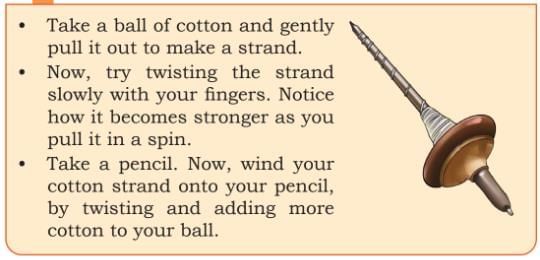
Explanation:
1. Take some cotton and gently pull it so you get a long, thin piece.
2. Twist the cotton strand with your fingers. As you twist, you will see the cotton gets stronger and doesn’t break easily.
3. Wrap the twisted cotton around a pencil, making a small ball.
What does this show?
When you twist cotton fibres, they stick together and become strong. This is how thread or yarn is made from cotton before it is turned into cloth.
Page No. 138
Activity 4

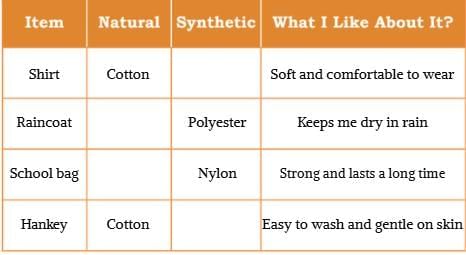
Page No. 139
Activity 5
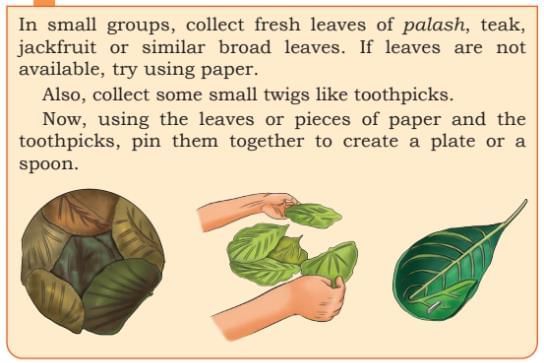
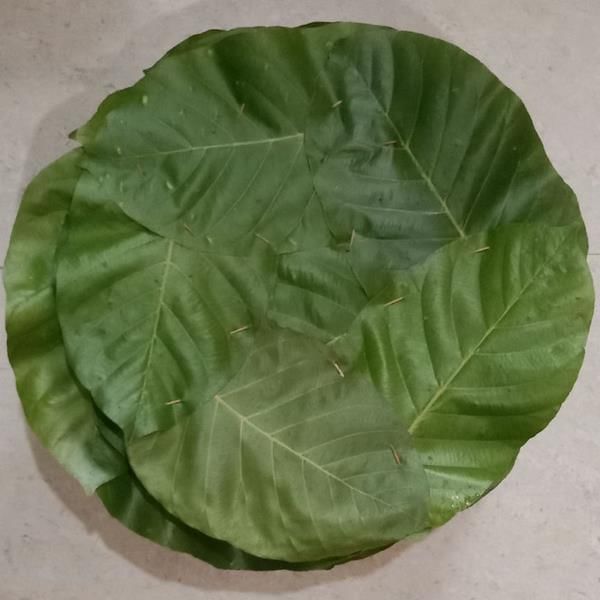
Activity 6

Answer: What is Stitching?
Stitching is joining pieces of fabric together by sewing with a needle and thread. It can be used to repair clothes or make new items.
Things You Need:
- A needle (a small, sharp tool with a hole called the eye for thread)
- Thread (a thin strand of cotton, nylon, or polyester)
- A piece of fabric to practice on
- A button (if you want to sew one on)
- Small scissors to cut the thread
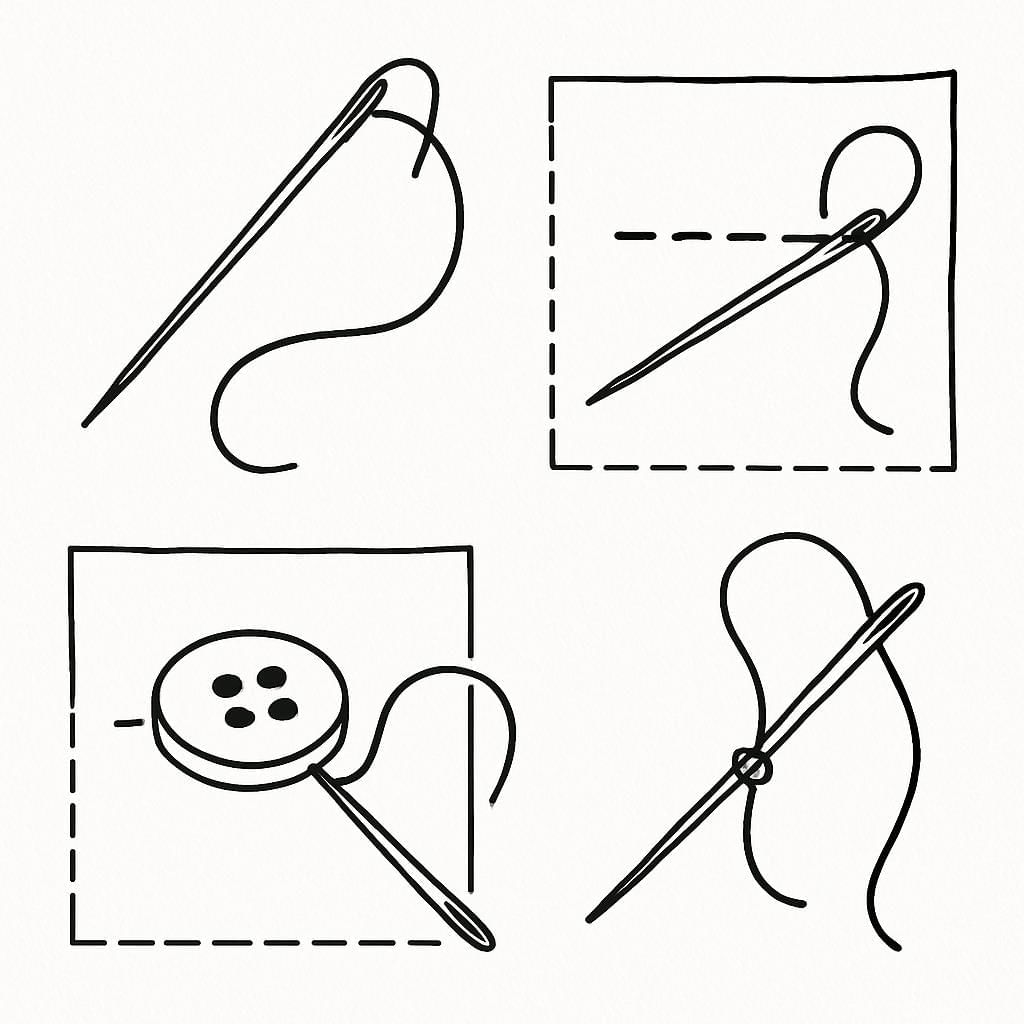
Think
Q. Have you seen someone stitching at home or in your neighbourhood? What were they making or fixing?
Answer: My mother is sewing buttons on my kurta (shirt).
Q. Look at your shirt or school bag. Can you find where the pieces have been stitched together?
Answer: Yes, pieces are stitched along the edges; seams and hems show stitches.
Page No. 140
Activity 7
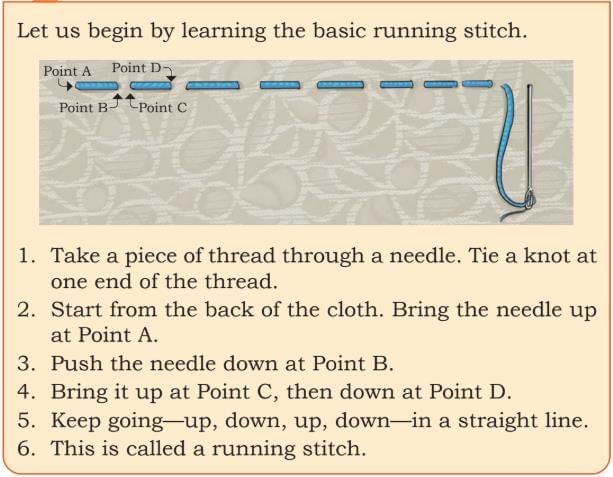
Students are advised to do this under the supervision of parents or teachers.
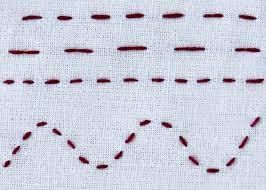
Page No. 141
Activity 8
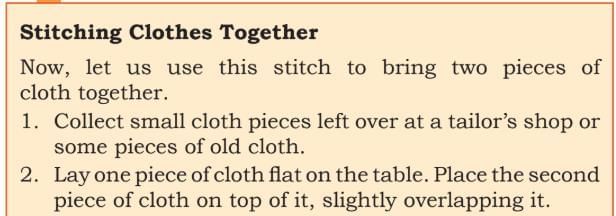
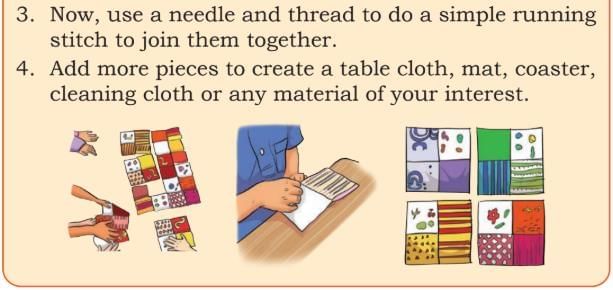
Q. Where else can we use running stitches in daily life?
Answer: Running stitches are used daily for simple repairs like fixing small holes in clothes, holding fabric pieces together temporarily, gathering fabric for ruffles, and basic hand embroidery. They are easy, quick, and versatile for both mending and decorative purposes.
Q. If one thread breaks in your stitching, what do you think will happen to the rest?
Answer: The stitching may loosen or come apart, showing that every thread is important.
Page 143-144
Let Us Reflect
1. Have you ever reused or recycled an old piece of cloth? What did you or your family make from it?
Answer: Yes, old pieces of cloth can be reused or recycled in many ways. For example, families often turn old clothes into cleaning rags, patchwork quilts, cushion covers, bags, or craft items. This helps reduce waste and gives new life to materials that would otherwise be thrown away.
2. If one thread breaks in a stitched cloth or a woven mat, what might happen? Why is each thread important?
Answer: If one thread breaks in a stitched cloth or woven mat, the fabric or mat may weaken and could start to come apart at that spot. Each thread is important because all the threads together hold the cloth or mat tightly. When one thread breaks, it reduces the strength and may cause other threads nearby to loosen or break over time.
3. Visit a tailor’s shop or a handloom store with an adult. What tools or machines did you see being used there?
Answer: In a tailor’s shop or handloom store, you may see many tools and machines, including:
- Sewing machines for stitching clothes quickly and neatly
- Scissors and measuring tapes for cutting fabric
- Needles and threads used for hand sewing
- Handlooms are used to weave fabric by interlacing threads
- Ironing or pressing tools to smooth the fabric after sewing
4. Find out what kind of weaving or stitching work is famous in your area or state. Name it.
Answer: The famous weaving or stitching work depends on your region. For example, in India, Banarasi silk from Varanasi, Kanjeevaram silk from Tamil Nadu, Phulkari embroidery from Punjab, or Chikankari embroidery from Lucknow are well-known. You can ask locals or visit a handloom store to find out which craft is famous in your area.
5. We should not throw the old clothes away. Why?
Answer: We should not throw old clothes away because they can be reused or recycled to make new, useful items, reducing waste. Throwing them away adds to landfill pollution and wastes the resources used to make the fabric. Old clothes can also be donated to help people in need, saving money and protecting the environment.
6. Below are the jumbled-up steps of the life cycle of a moth. Read and number them from 1 to 6 in the correct order.
- The adult moth comes out of the cocoon.
- Eggs hatch into tiny caterpillars.
- The silk moth lays eggs.
- The cycle begins again.
- Caterpillars eat mulberry leaves and grow big.
- Caterpillars spin cocoons around themselves.
Answer:
- The silk moth lays eggs.
- Eggs hatch into tiny caterpillars.
- Caterpillars eat mulberry leaves and grow big.
- Caterpillars spin cocoons around themselves.
- The adult moth comes out of the cocoon.
- The cycle begins again.
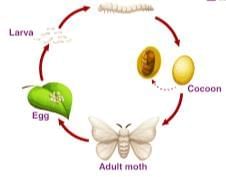
7. Bring 5–6 pieces of different types of clothes from home or nearby tailors (leftover scraps). Observe the material closely and complete the table. Ask an elder or search in your book to find out whether it is made from cotton, wool, silk, jute, polyester or nylon.
Answer: 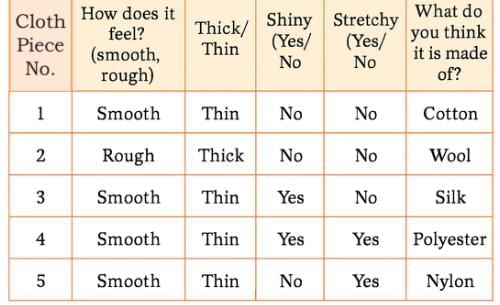
|
11 videos|214 docs|10 tests
|
FAQs on Clothes-How Things are Made NCERT Solutions - Our Wondrous World Class 5 - New NCERT
| 1. What are natural fibres, and how are they different from synthetic fibres? |  |
| 2. What is the significance of weaving in traditional clothing? |  |
| 3. How are threads made, and what materials are commonly used? |  |
| 4. What are some common crafting techniques using needle and thread? |  |
| 5. How do natural and synthetic fibres impact the environment? |  |




















